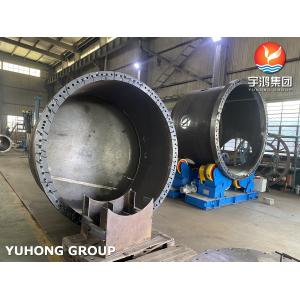

Add to Cart
Shell and Tube Exchanger
A shell and tube exchanger is a type of heat exchanger that
consists of a shell (or outer vessel) and a bundle of tubes inside
it. The shell and tube exchanger is used for transferring heat
between two fluids, typically a hot fluid and a cold fluid.
The hot fluid flows through the tubes, while the cold fluid flows
around the tubes in the shell. Heat is transferred from the hot
fluid to the cold fluid through the tube walls. The fluids can be
in either a parallel flow or a counterflow arrangement, depending
on the desired heat transfer efficiency.
The shell and tube exchanger design allows for a large surface area
for heat transfer, making it efficient for a wide range of
applications. It is commonly used in industries such as oil and
gas, chemical processing, power generation, and HVAC.
Some advantages of shell and tube exchangers include their high
heat transfer efficiency, ability to handle high pressures and
temperatures, and ease of maintenance. However, they can be more
expensive to manufacture and require more space compared to other
types of heat exchangers.
Shell and tube exchangers are widely used in various industries due to their versatility, reliability, and effectiveness in transferring heat between fluids.
Application
1. HVAC Systems: Shell and tube heat exchangers are commonly used
in heating, ventilation, and air conditioning (HVAC) systems to
transfer heat between the hot and cold fluid streams. They are used
for applications such as heating or cooling air, water, or
refrigerants.
2. Power Plants: Shell and tube heat exchangers are used in power
plants for various heat transfer processes. They are used to cool
condensers by transferring heat from the steam to the cooling
water. They are also used in the cooling systems of gas turbines
and steam turbines.
3. Petrochemical Industry: Shell and tube heat exchangers are
extensively used in the petrochemical industry for various
processes such as cooling or heating of process fluids, condensing
or vaporizing gases, and preheating feedwater. They are used in
processes such as distillation, cracking, and reforming.
4. Food and Beverage Industry: Shell and tube heat exchangers are
used in the food and beverage industry for processes such as
pasteurization, sterilization, and cooling. They are used to heat
or cool food products, beverages, or process fluids.
5. Chemical Industry: Shell and tube heat exchangers are widely
used in the chemical industry for various heat transfer processes.
They are used for heating or cooling of process fluids, condensing
or vaporizing gases, and preheating or cooling of reactants.
6. Oil and Gas Industry: Shell and tube heat exchangers are used in
the oil and gas industry for processes such as crude oil refining,
natural gas processing, and liquefied natural gas (LNG) production.
They are used for heating or cooling of process fluids, condensing
or vaporizing gases, and preheating or cooling of feedstocks.
7. Pharmaceutical Industry: Shell and tube heat exchangers are used
in the pharmaceutical industry for processes such as sterilization,
drying, and cooling. They are used to heat or cool process fluids,
remove moisture from products, and maintain controlled temperatures
during manufacturing processes.
